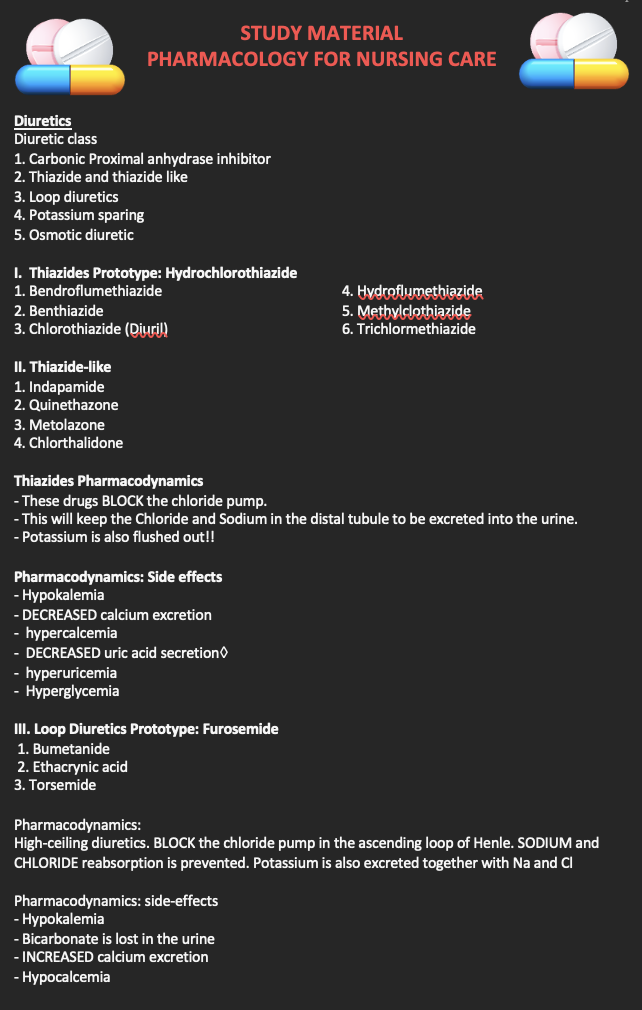Pharmacology for Nursing Care
Summary:
This study material covers various classes of diuretics used in nursing care, including Carbonic Anhydrase Inhibitors, Thiazides, Thiazide-like diuretics, Loop Diuretics, Potassium-sparing diuretics, and Osmotic Diuretics. Each class’s prototype drugs, pharmacodynamics, and side effects are outlined. The nursing process for administering diuretics is also discussed, including assessment, nursing diagnosis, implementation, and evaluation.
Another section of the study material focuses on anxiolytics and hypnotics. It explains that anxiolytics prevent anxiety, sedatives calm individuals and make them unaware of their environment, and hypnotics induce sleep. Benzodiazepines and barbiturates are listed as drugs used for these purposes, along with their mechanisms of action, clinical indications, and adverse effects. CNS stimulants are briefly mentioned as drugs for treating certain disorders such as ADHD, obesity, and narcolepsy.
The study material provides essential information for nurses to understand diuretics and anxiolytics, enabling them to administer these medications safely and effectively to patients.
Excerpt:
Pharmacology for Nursing Care
Diuretics
Diuretic class
1. Carbonic Proximal anhydrase inhibitor
2. Thiazide and thiazide like
3. Loop diuretics
4. Potassium-sparing
5. Osmotic diuretic
I. Thiazides Prototype: Hydrochlorothiazide
1. Bendroflumethiazide
2. Benthiazide
3. Chlorothiazide (Diuril)
4. Hydroflumethiazide
5. Methylclothiazide
6. Trichlormethiazide
II. Thiazide-like
1. Indapamide
2. Quinethazone
3. Metolazone
4. Chlorthalidone
Thiazides Pharmacodynamics
– These drugs BLOCK the chloride pump.
– This will keep the Chloride and Sodium in the distal tubule to be excreted into the urine.
– Potassium is also flushed out!!
Pharmacodynamics: Side effects
– Hypokalemia
– DECREASED calcium excretion
– hypercalcemia
– DECREASED uric acid secretion
– hyperuricemia
– Hyperglycemia
III. Loop Diuretics Prototype: Furosemide
1. Bumetanide
2. Ethacrynic acid
3. Torsemide
Pharmacodynamics:
High-ceiling diuretics. BLOCK the chloride pump in the ascending loop of Henle. SODIUM and CHLORIDE reabsorption is prevented. Potassium is also excreted together with Na and Cl
Pharmacodynamics: side-effects
– Hypokalemia
– Bicarbonate is lost in the urine
– INCREASED calcium excretion
– Hypocalcemia
– Ototoxicity- due to the electrolyte imbalances
IV. Potassium-sparing diuretics
Prototype: Spironolactone
1. Amiloride
2. Triamterene
Pharmacodynamics:
Spironolactone is an ALDOSTERONE antagonist
Triamterene and Amiloride BLOCK the potassium secretion in the distal tubule
The diuretic effect is achieved by the sodium loss to offset potassium retention


Reviews